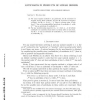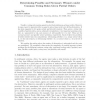102
Voted
ICALP
2010
Springer
14 years 10 months ago
2010
Springer
In this paper, we focus our attention on the fragment of Halpern and Shoham's modal logic of intervals (HS) that features four modal operators corresponding to the relations &...
ORDER
2002
15 years 1 days ago
2002
We show that: (1) For many regular cardinals (in particular, for all successors of singular strong limit cardinals, and for all successors of singular -limits), for all n {2, 3, ...
102
click to vote
AI
2006
Springer
15 years 14 days ago
2006
Springer
This paper demonstrates how machine learning methods can be applied to deal with a realworld decipherment problem where very little background knowledge is available. The goal is ...
106
click to vote
CSL
2010
Springer
15 years 1 months ago
2010
Springer
d Abstract) Thomas Schwentick and Thomas Zeume TU Dortmund University The finite satisfiability problem for two-variable logic over structures with unary relations and two order re...
122
click to vote
AAAI
2008
15 years 2 months ago
2008
Usually a voting rule requires agents to give their preferences as linear orders. However, in some cases it is impractical for an agent to give a linear order over all the alterna...
112
Voted
MFCS
2009
Springer
15 years 5 months ago
2009
Springer
Abstract. To make a joint decision, agents (or voters) are often required to provide their preferences as linear orders. To determine a winner, the given linear orders can be aggre...


